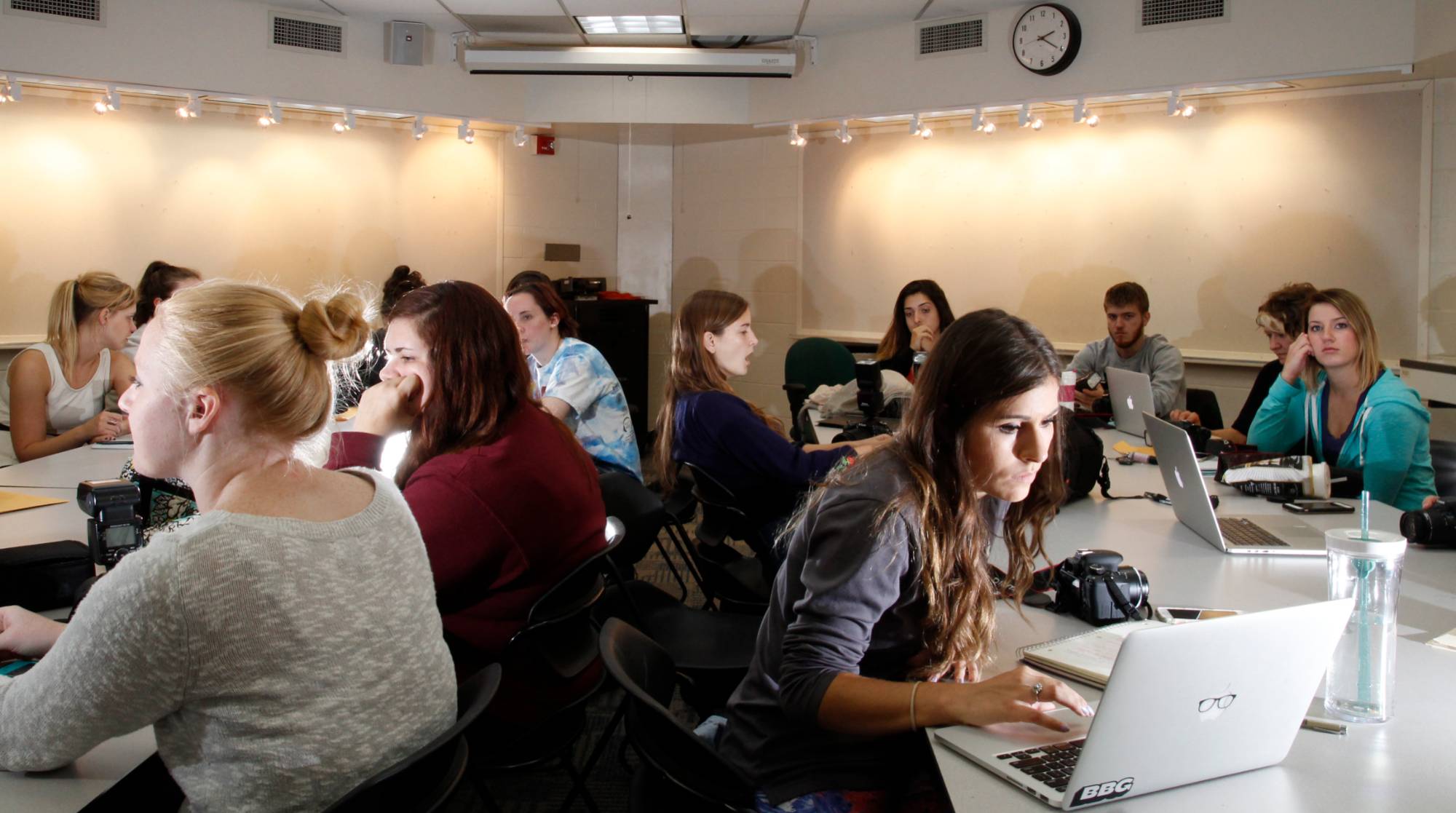Major and Minor Requirements
Major Requirements
The photography program, in supporting its mission, develops liberally-educated professional image-makers and media scholars through student-centered inquiry and practice in visual communication and the history, theory, criticism, and production of photographic images using state of the art methods, tools and facilities.
Students are encouraged to explore a variety of photographic formats, including 35mm and 4x5 view camera, and to acquire experience in black-and-white, color, and digital imaging processes.
Please consult the GVSU catalog for further information and general education requirements. For more information, consult your academic advisor.
Advising Guide for students who entered before fall 2022.
Advising Guide for students who enter from the fall of 2022 and beyond.

Curriculum
Working closely with a faculty advisor, students plan at least 37 semester credits directly relating to photography, plus the communications core (nine credits), and the Capstone (three credits). Students connect photography to related fields in the visual arts, performing arts, business, media and publications, and the humanities. The emphasis of the photography program is on the students’ growth as educated picture makers who not only know photography, but also know something about themselves, about the world around them, and about the culture that has shaped them. Students are expected to develop a working knowledge in many areas of visual communication and are encouraged to pursue elective studies in areas that provide a broad understanding of social and cultural issues and the role of the visual communicator in contemporary society.
|
Requirements |
Credits |
|---|---|
|
Required Courses |
37 |
|
Photography Elective Courses |
9 |
|
VMA Elective Courses |
3 |
|
Program Requirements for BA or BS degree |
9 |
|
University General Education Required Courses |
43 |
|
Total Credits |
101 |
Required Courses
Students take nine courses in this category, for a minimum of 37 credits
- COM 101 Concepts of Communication (3 Credits)
- COM 295 OR ART 222 Art History 2 (3 Credits)
- FVP 125 Media 1 (Intro to Video) (3 Credits)
- ART 150 - Introduction to Visual Composition (3 credits)
- PHO 170 - Introduction to Photography (3 credits)
- PHO 171 - Darkroom Photography (4 credits)
- PHO 266 - History of Photography I (3 credits)
- PHO 272 - Intermediate Photography (3 credits)
- PHO 279 - Color Photography (3 credits)
- PHO 366 - History of Photography II (3 credits)
- PHO 375 - Studio Photography 1(3 credits)
- PHO 495 - Photography Capstone and Thesis Seminar (1 to 6 credits)
Elective Courses
Students must complete a minimum of 12 credits in this category.
Any ART or FVP course not listed above plus 9 credits from the following list:
- PHO 273 - Classic 4 x 5 Photography (3 credits)
- PHO 368 - Alternative Printing Processes (3 credits)
- PHO 371 - Experimental Photography (3 credits)
- PHO 373 - Advanced Digital Photography (3 credits)
- PHO 377 - The Social Eye (4 credits) (offered in Fall of even years)
- PHO 378 - Advanced Problems in Photography (3 credits)
- PHO 399 - Independent Study (1 to 6 credits)
- PHO 475 - Studio Photography 2
- PHO 490 - Internship (1 to 6 credits)
- PHO 280/380/480 Special Topics (TBA) (3 credits)
B.A. or B.S. Cognate Requirements
Both the BA and the BS degrees require 9 (nine) credits in cognate areas
BA IN PHOTOGRAPHY
The Bachelor of Arts degree in photography requires a third-semester proficiency in a foreign language of the student’s choice.
BS IN PHOTOGRAPHY
The Bachelor of Science degree in photography requires the following three courses:
- STA 215 - Introductory Applied Statistics (3 credits)
- COM 275 - Foundations of Communication Research (3 credits)
- COM 375 - Communication Research (3 credits)
General Education Courses
Students must refer to the General Education Handbook for information on General Education Requirements.
The Grand Valley State University General Education Program provides a broad-based liberal education experience that fosters lifelong learning and informed citizenship. The Program prepares students for intelligent participation in public dialogues that consider the issues of humane living and responsible action in local, national, and global communities.
Suggested Freshman Sequence
|
Fall Semester |
Winter Semester |
|---|---|
|
PHO 170 Introduction to Photography |
ART 150 Introduction to Visual Composition |
|
PHO 266 History of Photography 1 |
PHO 272 Intermediate Photography or PHO 171 Darkroom Photography |
Minor Requirements
|
Requirements |
Credits |
|---|---|
|
Required Courses |
9 - 10 |
|
Elective Courses |
12 |
|
Total Credits |
21 - 22 |
Required Courses
Students take these courses in this category, for a minimum of 9 credits:
- PHO 170 Introduction to Photography (Digital) or PHO 171 Darkroom Photography (Film)
- PHO 266 History of Photography 1
- PHO 272 Intermediate Photography
Elective Courses
Students choose 4 courses from the following, for a minimum of 12 credits:
- PHO 273 - Classic 4x5 Photography (Darkroom) (3 credits)
- PHO 279 - Color Photography (3 credits)
- PHO 366 - History of Photography II (3 credits)
- PHO 371 - Experimental B&W Photography (3 credits)
- PHO 373 - Advanced Photography (3 credits)
- PHO 368 - Alternative Photographic Print Processes (3 credits)
- PHO 375 - Studio Photography 1 (3 credits)
- PHO 377 - The Social Eye (Documentary) (4 credits)
- PHO 378 - Advanced Problems (3 credits)
- PHO 380 - Special Topics In Photography (1 to 6 credits)
- PHO 399 - Independent Study (1 to 6 credits)
- PHO 475 - Studio Photography 2 (3 credits)
- PHO 490 - Internship (1 to 6 credits)
Questions
For degree requirement questions, please consult your academic advisor in the Department of Visual and Media Arts or the CLAS Advising Center.

